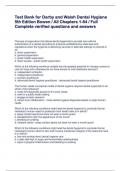Test Bank for Darby and Walsh Dental Hygiene
5th Edition Bowen / All Chapters 1-64 / Full
Complete verified questions and answers
The type of supervision that allows dental hygienists to provide care without
authorization of a dentist according to protocols established by state laws and
regulations when the hygienist is delivering services in alternate settings is referred to
as:
a. direct supervision
b. general supervision
c. public health supervision
d. direct access - public health supervision
Which of the following workforce models has the greatest potential to increase access to
care for those who otherwise do not have access to oral healthcare services?
a. independent contractor
b. independent practitioner
c. auxiliary practitioner
d. advanced dental hygiene practitioner - advanced dental hygiene practitioner
The human needs conceptual model of dental hygiene requires dental hygienists to do
which of the following?
a. make DH diagnoses based on 8 human needs
b. work in a public health setting
c. engage in basic research
d. refrain from collaboration - make dental hygiene diagnoses based on eight human
needs
Which of the following conditions might lead the dental hygienist to conclude that an
individual's human need for protection from health risks is in deficit?
a. plays contact sports but does not wear a mouth guard
b. dissatisfaction with the appearance of her mouth
c. bleeding on probing
d. rampent caries - plays contact sports but does not wear a mouth guard
Which of the following conditions might lead the dental hygienist to conclude that an
individual's human need for skin and mucous membrane integrity of the head and neck
is in deficit?
a. fear and anxiety about dental hygiene care
b. a daily diet high in sugar and fermentable carbohydrates
c. signs of gingival inflammation and bleeding on probing
,d. dissatisfaction with appearance of teeth - signs of gingival inflammation and bleeding
on probing
Devan Sacks, age 12, is a new client in the dental practice and has been scheduled for
dental hygiene care. Devan is in the seventh grade, is one of the star players on the
girls' soccer team, and wears an athletic mouth guard protector. She is accompanied by
her mother, Margaret, age 32, and her sister Bridget, age 10. After completing health,
dental, and dental hygiene histories, the dental hygienist assesses the teeth,
periodontium, and oral self-care skills. Significant findings include gingival inflammation,
bleeding on probing around some teeth, and poor oral hygiene. Client has a knowledge
deficit regarding biofilm, periodontal disease process, and personal oral health status.
If a gingival disease such as localized juvenile periodontitis is suspected, the most
important dental hygiene action would be which of the following?
a. oral health instruction
b. scaling and root planning
c. referral to the dentist f - referral to the dentist for a dental diagnosis
Which of the following is not one of the central concepts in the paradigm for the
discipline of dental hygiene?
a. client
b. environment
c. health and oral health
d. patient
e. dental hygiene actions - patient
Which of the following is not a step in the dental hygiene process of care?
a. assesment
b. planning
c. evaluation
d. diagnosing
e. implementation
f. verification
g. documentation - verification
The Collaborative Practice Model primarily emphasizes which of the following?
a. the concept of multiple categories of DH care
b. the role of the DH as a public health educator
c. DH working with other health care providers to provide optimum client care
d. the role of the DH as a dental auxillary - DH working with other health care providers
to provide optimum client care
The term "client" is frequently preferred in healthcare settings for which of the following
reasons?
a. it connotes wellness as a well as illness and suggests an active participant in
healthcare
, b. it suggests a sick, dependent person who is in need of therapy
c. it is limited to an individual
d. it focuses on the control of the clinician - it connotes wellness as well as illness and
suggests an active participant in healthcare
The occupational model of dental hygiene:
a. prepares dental hygienists to improve DH care through the advancement of DH theory
b. is based on the mentorship of a dentist
c. views the DH as a primary care provider
d. supports unsupervised DH practice to increase public access to oral healthcare - is
based on the mentorship of a dentist
The professional model of dental hygiene emphasizes that the dental hygienist:
a. implements preventive treatment plans developed by the dentist
b. views the DH as a secondary care provider
c. is technology based
d. implements self-generated preventive oral care regimens - implements self-generated
preventive oral care regimens
The seven roles of the dental hygienist are which of the following?
a. Periodontal clinician, pedodontic clinician, researcher, change agent, advocate,
educator
b. Clinician, theory builder, educator, researcher, change agent, advocate, public health
c. Clinician, administrator, researcher, public health, educator, corporate, entrepreneur
d. Clinician, administrator, manager, educator, researcher, advocate, public health -
clinician, administrator, researcher, public health, educator, corporate, entrepreneur
Accreditation:
a. Is a formal, voluntary, nongovernmental process that establishes a minimum set of
standards to ensure quality in educational institutions
b. Serves as a mechanism to protect the public
c. Requires descriptions of all tasks that a beginning dental hygiene practitioner must
consistently perform accurately and efficiently
d. all of the above - all of the above
Dental practice acts:
a. Do not establish criteria for dental hygiene education or licensure
b. Are laws established in each state (United States) or province (Canada) to regulate
the practice of dental hygiene
c. Are limited in terms of defining dental hygiene practice
d. all of the above - are laws established in each state (United States) or province
(Canada) to regulate the practice of dental hygiene
An administrator or manager:
a. Is a person whose official position is to guide and direct the work of others
b. does not provide clinical care




